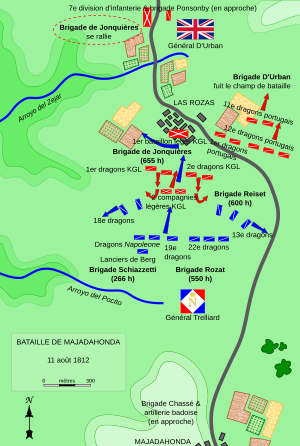Battle of Majadahonda facts for kids
Quick facts for kids Battle of Majadahonda |
|||||
|---|---|---|---|---|---|
| Part of the Peninsular War | |||||
 |
|||||
|
|||||
| Belligerents | |||||
|
|||||
| Commanders and leaders | |||||
| Strength | |||||
| 2,000 | 2,300 | ||||
| Casualties and losses | |||||
| 200 killed, wounded or captured | 176–200 killed, wounded or captured | ||||
The Battle of Majadahonda happened on August 11, 1812, near Majadahonda, Spain. It was a cavalry battle during the Peninsular War. In this fight, French cavalry led by General Anne-François-Charles Trelliard attacked British and Portuguese cavalry. These forces were the advance guard (the front part) of Wellington's army.
The French cavalry first pushed back the Portuguese horsemen and captured three British cannons. Then, cavalry from the King's German Legion (KGL) stepped in to stop the French. Even though the KGL fought bravely, they had to pull back when more French cavalry joined the fight. The French cavalry could not defeat a KGL infantry (foot soldiers) group defending a village. They finally retreated when more British soldiers arrived. This battle took place about 16 kilometers (10 miles) northwest of Madrid.
Contents
The Battle Begins
After his big win at the Battle of Salamanca, General Wellington moved his combined British and Portuguese army towards Madrid. On August 11, the 1st, 11th, and 12th Dragoons (a type of cavalry) from D'Urban's Portuguese group were leading Wellington's army.
Behind them was a group of heavy dragoons from the King's German Legion (KGL). Further back were KGL light infantry battalions and some Brunswick Oels soldiers.
Surprise Attack
General D'Urban's Portuguese cavalry were surprised by Trelliard's French cavalry division. This French group included several dragoon regiments from France, Westphalia, and Italy. The Portuguese horsemen were quickly forced to retreat, and three of their cannons were lost. D'Urban was very disappointed with his soldiers' performance. He felt they did not fight as bravely as they had in earlier battles.
KGL Intervention
Soon after, the KGL heavy dragoons arrived. The Portuguese horsemen then regrouped behind them. With help from the 1st KGL Light Infantry battalion, the combined British and Portuguese forces managed to stop the French advance.
General Trelliard decided to pull back his troops when he heard that more Allied (British and Portuguese) soldiers were coming. The next morning, the Allied forces entered Majadahonda and found the cannons that had been lost.
Battle Outcome
About 2,300 British and Portuguese soldiers fought against around 2,000 French soldiers. The French lost about 200 soldiers killed, wounded, or captured. The British and Portuguese lost between 176 and 200 soldiers.
The KGL forces had 14 killed, 40 wounded, and 7 captured. D'Urban's Portuguese group reported 33 killed, 52 wounded, and 23 captured. The KGL infantry had 7 soldiers wounded.
Impact on King Joseph
General Trelliard's report about the battle caused King Joseph Bonaparte (Napoleon's brother, who was then King of Spain) to quickly leave Madrid the very next day. The next major action in the war was the Siege of Burgos.
The British and Portuguese advance guard suffered a lot at Majadahonda. In less than an hour, they lost 200 men and 3 cannons. Two of their commanders were also captured. The French later abandoned the captured cannons after burning their carriages. The French had fewer losses, with one officer killed and 15 wounded.
Wellington's View
The KGL Dragoons were praised for their bravery in this battle. However, the Portuguese dragoons were seen as not having fought well. Marshal Beresford, who commanded the Portuguese Army, wanted to punish them. He suggested they should not ride horses or carry swords until they could prove themselves in battle again.
However, Wellington had a different idea. He felt that sending the cavalry away was not possible because they still needed all their soldiers. He believed that even if the Portuguese cavalry did not fight perfectly, having them was better than having no cavalry at all. He decided they should not be used alone or with the faster British cavalry in the future.
See also
 In Spanish: Batalla de Majadahonda para niños
In Spanish: Batalla de Majadahonda para niños

